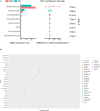The Relationship Between Lower Respiratory Tract Microbiome and Allergic Respiratory Tract Diseases in Children
- PMID: 34054744
- PMCID: PMC8160472
- DOI: 10.3389/fmicb.2021.630345
The Relationship Between Lower Respiratory Tract Microbiome and Allergic Respiratory Tract Diseases in Children
Abstract
Similar to those in the upper respiratory tract, there are microbes present in the healthy human lower respiratory tract (LRT), including the lungs and bronchus. To evaluate the relationship between LRT microbiome and allergic respiratory diseases in children, we enrolled 68 children who underwent bronchoscopy from January 2018 to December 2018 in the affiliated hospital of the Capital Institute of Pediatrics. Using the total IgE (TIgE) values, children were divided into two groups: allergy sensitivity (AS) group and non-allergy sensitivity (NAS) group. Nucleic acid was extracted from samples of bronchoalveolar lavage fluid (BALF) from the two groups of children taken during bronchoscopy treatment and the 16S rDNA gene was sequenced and analyzed. The results showed that Haemophilus, Moraxella, Streptococcus, Prevotella, Neisseria, and Rothia were detected in all patients. There was a statistically significant difference in the composition and distribution of microbiota between the AS and NAS groups (p < 0.01). Analysis of the correlation of clinical indices and microbiome showed that TIgE was positively correlated with Bacteroidetes and negatively correlated with Streptococcus. Absolute lymphocyte count showed a relationship with Streptococcus, and the absolute neutrophil count or percentage of neutrophils showed a relationship with Cardiobacterium. The LRT microbiome functioned similarly to the intestinal microbiome. That is, the decrease in microbial diversity and the change in composition could lead to an increase in allergic symptoms. The microbiome of the LRT in children, especially that of Bacteriodetes and Streptococcus, showed a correlation with respiratory allergic diseases.
Keywords: allergic respiratory tract diseases; bronchoalveolar lavage fluid; children; lower respiratory tract; microbiome.
Copyright © 2021 Cui, Zhang, Zhao, Sun, Chen, Zhang, Yan, Xue, Li, Feng, Liu, Xie and Yuan.
Conflict of interest statement
The authors declare that the research was conducted in the absence of any commercial or financial relationships that could be construed as a potential conflict of interest. The handling editor declared a shared affiliation with the authors YZ, ZC, QZ at the time of the review.
Figures





Similar articles
-
Bacteria from bronchoalveolar lavage fluid from children with suspected chronic lower respiratory tract infection: results from a multi-center, cross-sectional study in Spain.Eur J Pediatr. 2018 Feb;177(2):181-192. doi: 10.1007/s00431-017-3044-3. Epub 2017 Dec 29. Eur J Pediatr. 2018. PMID: 29285648 Free PMC article. Clinical Trial.
-
Shared and Specific Lung Microbiota with Metabolic Profiles in Bronchoalveolar Lavage Fluid Between Infectious and Inflammatory Respiratory Diseases.J Inflamm Res. 2022 Jan 11;15:187-198. doi: 10.2147/JIR.S342462. eCollection 2022. J Inflamm Res. 2022. PMID: 35046693 Free PMC article.
-
Characterization of the Microbiome and Host's Metabolites of the Lower Respiratory Tract During Acute Community-Acquired Pneumonia Identifies Potential Novel Markers.Infect Drug Resist. 2023 Jan 26;16:581-594. doi: 10.2147/IDR.S394779. eCollection 2023. Infect Drug Resist. 2023. PMID: 36726385 Free PMC article.
-
[The airways microbial community composition in healthy individuals and bronchial asthma patients].Vestn Ross Akad Med Nauk. 2014;(3-4):71-6. doi: 10.15690/vramn.v69i3-4.999. Vestn Ross Akad Med Nauk. 2014. PMID: 25306600 Review. Russian.
-
Does lung microbiome play a causal or casual role in asthma?Pediatr Pulmonol. 2018 Oct;53(10):1340-1345. doi: 10.1002/ppul.24086. Epub 2018 Jun 26. Pediatr Pulmonol. 2018. PMID: 29943915 Review.
Cited by
-
Management of patients with allergic diseases in the era of COVID-19.Clin Exp Pediatr. 2022 Nov;65(11):529-535. doi: 10.3345/cep.2022.00759. Epub 2022 Sep 23. Clin Exp Pediatr. 2022. PMID: 36229025 Free PMC article.
-
Airway Bacterial Biodiversity in Exhaled Breath Condensates of Asthmatic Children-Does It Differ from the Healthy Ones?J Clin Med. 2022 Nov 16;11(22):6774. doi: 10.3390/jcm11226774. J Clin Med. 2022. PMID: 36431251 Free PMC article.
-
Temporal Dynamics of the Nasopharyngeal Microbiome and its Relationship with Childhood Asthma Exacerbation.Microbiol Spectr. 2022 Jun 29;10(3):e0012922. doi: 10.1128/spectrum.00129-22. Epub 2022 May 12. Microbiol Spectr. 2022. PMID: 35546575 Free PMC article.
-
Immunologic, genetic, and ecological interplay of factors involved in allergic diseases.Front Allergy. 2023 Aug 3;4:1215616. doi: 10.3389/falgy.2023.1215616. eCollection 2023. Front Allergy. 2023. PMID: 37601647 Free PMC article. Review.
-
Nasal Microbiome Change During and After Exacerbation in Asthmatic Children.Front Microbiol. 2022 Mar 4;12:833726. doi: 10.3389/fmicb.2021.833726. eCollection 2021. Front Microbiol. 2022. PMID: 35310400 Free PMC article.
References
-
- Bisgaard H., Li N., Bonnelykke K., Chawes B. L., Skov T., Paludan-Müller G., et al. (2011). Reduced diversity of the intestinal microbiota during infancy is associated with increased risk of allergic disease at school age. J. Allergy Clin. Immunol. 128 646–652. 10.1016/j.jaci.2011.04.060 - DOI - PubMed
LinkOut - more resources
Full Text Sources
Other Literature Sources
Research Materials

